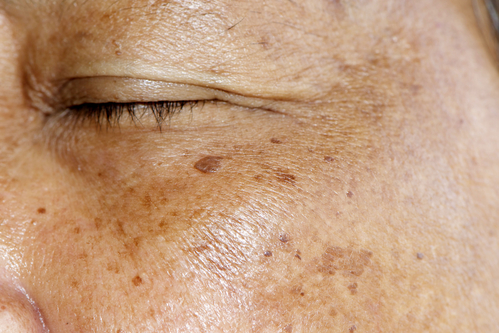
Understanding the difference between a freckle, an acne mark, and melasma can help you know if the hyperpigmentation is something to be alarmed over, or whether there are treatment options available to correct the dark spots if they are something that bother you.
Do you suffer from hyperpigmentation?
Types of Hyperpigmentation
Hyperpigmentation is a buildup of melanin, the dark pigment that colors our skin, hair, and eyes. The body uses melanin to protect the DNA of epidermal cells from the harmful UV rays of the sun. There are many forms of hyperpigmentation, with some more common than others.
Freckles
When the skin is exposed to the sun, UV B radiation triggers melanocytes to produce more melanin to protect the skin. The melanin builds up into a localized spot and diffuses into the surrounding skin cells called keratinocytes, which leaves behind a freckle.
Dark Spots
Age spots, sun spots, or liver spots are all different names for the same type of hyperpigmentation known as solar lentigos. These spots typically occur on the face, neck, chest and on the backs of the hands. While age spots typically begin to appear later in life, they are actually caused by sun exposure, not aging. When UV radiation causes melanocytes to multiply, age spots appear. Bigger than freckles, age spots are sharply defined and are typically black, brown, or grey in color.
Melasma
Typically found in women during their reproductive years, Melasma can occur anywhere on the body and is typically found on the cheeks, jawline, forehead and around the mouth. Melasma is a common form of hyperpigmentation and is most commonly caused by UV exposure from the sun. Hormonal changes, such as those you experience during pregnancy, can trigger melasma.
Acne Scars
These pigmentation scars are found after acne has cleared. These marks are flat spots of discoloration and can range in color from pink to black depending on your skin type. Dark acne marks that are brown or black in color at typically your body’s response from Post Inflammatory Hyperpigmentation, or PIH.
Can I Remove My Brown Spots?
During your consultation, Laser Aesthetic Center will evaluate your skin and help you discover different treatment options that are the perfect fit for your skin and your needs. We may recommend any of the following treatments:
IPL Treatments. Intense pulsed light treatments break up discoloration and help brown spots flake gently off your skin.
Laser Skin Resurfacing. We offer a gentle alternative to ablative laser resurfacing with the PicoSure Focus. Patients are able to see improvements in their skin tone, texture and tightness.
Cosmetic Injections. Botox or dermal fillers might be helpful for facial lines that have been caused by the sun’s damaging rays that have caused exaggerated aging.
Laser Skin Tightening. Titan skin tightening stimulates collagen healing and internal, natural improvements in elasticity.
Preventing Future Brown Spots
As you read through the different types of hyperpigmentation, you probably began to notice one common theme when it comes to what causes these spots to become present. Yes, you guessed it…UV rays are the main cause behind hyperpigmentation.
Help prevent future brown spots by:
- Exfoliating
- Moisturizing
- Always wear at least an SPF 30 sunscreen on your body and face
- Don’t forget to reapply sunscreen throughout the day
- Cover up from the sun
- Avoid extended periods outside in the sun midday when the UV rays are strongest
Summer skincare Secrets
While it may feel nearly impossible to keep sun exposure from affecting your skin if you do suffer from hyperpigmentation, you can always up your efforts. Sun protection is about a lot more than just applying sunscreen once in the morning, and being proactive against sun damage every day throughout the summer will help you stroll into fall with damage-free skin.
Ask Laser Aesthetic Center for specific skincare recommendations at your next appointment!
